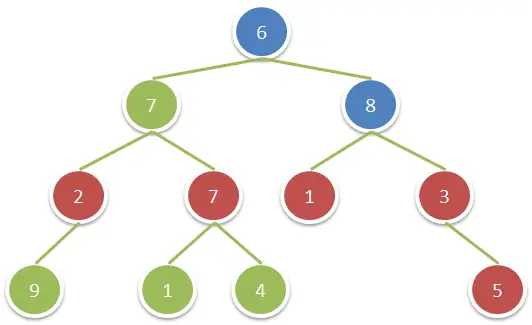Recursive Depth First Search Algorithm to Compute the Sum of Nod
- Time:2020-09-12 10:06:27
- Class:Weblog
- Read:36
Given a binary tree, return the sum of values of nodes with even-valued grandparent. (A grandparent of a node is the parent of its parent, if it exists.)
If there are no nodes with an even-valued grandparent, return 0.
binary-tree-grandparent
Example 1:
Input: root = [6,7,8,2,7,1,3,9,null,1,4,null,null,null,5]
Output: 18
Explanation: The red nodes are the nodes with even-value grandparent while the blue nodes are the even-value grandparents.Constraints:
The number of nodes in the tree is between 1 and 10^4.
The value of nodes is between 1 and 100.Hints:
Traverse the tree keeping the parent and the grandparent.
If the grandparent of the current node is even-valued, add the value of this node to the answer.
Depth First Search Algorithm to Pass the Parent and GrandParent Nodes
When we do a DFS (Depth First Search) Algorithm from the root, we can pass down the parent, and the grandparent nodes. Thus, when conditions are met (the grandparent nodes have even values), we accumulate the sum.
The implementation is done via Recursion, and the runtime complexity is O(N) where N is the number of the nodes in the binary tree. The space requirement is also O(N) where the binary tree in worst case may become the singly linked list and the usage of recursion yields the stack-calls.
The C++ code to traverse the binary tree in DFS:
1 2 3 4 5 6 7 8 9 10 11 12 13 14 15 16 17 18 19 20 21 22 23 24 25 26 | /** * Definition for a binary tree node. * struct TreeNode { * int val; * TreeNode *left; * TreeNode *right; * TreeNode(int x) : val(x), left(NULL), right(NULL) {} * }; */ class Solution { public: int sumEvenGrandparent(TreeNode* root) { dfs(root, nullptr, nullptr); return sum; } private: int sum = 0; void dfs(TreeNode* root, TreeNode* parent, TreeNode* grandparent) { if (root == nullptr) return; if (grandparent != nullptr && grandparent->val % 2 == 0) { sum += root->val; } dfs(root->left, root, parent); dfs(root->right, root, parent); } }; |
/**
* Definition for a binary tree node.
* struct TreeNode {
* int val;
* TreeNode *left;
* TreeNode *right;
* TreeNode(int x) : val(x), left(NULL), right(NULL) {}
* };
*/
class Solution {
public:
int sumEvenGrandparent(TreeNode* root) {
dfs(root, nullptr, nullptr);
return sum;
}
private:
int sum = 0;
void dfs(TreeNode* root, TreeNode* parent, TreeNode* grandparent) {
if (root == nullptr) return;
if (grandparent != nullptr && grandparent->val % 2 == 0) {
sum += root->val;
}
dfs(root->left, root, parent);
dfs(root->right, root, parent);
}
};And here is the Java code to visit the binary tree in DFS:
1 2 3 4 5 6 7 8 9 10 11 12 13 14 15 16 17 18 19 20 21 22 23 24 25 26 | /** * Definition for a binary tree node. * public class TreeNode { * int val; * TreeNode left; * TreeNode right; * TreeNode(int x) { val = x; } * } */ class Solution { private int sum = 0; public int sumEvenGrandparent(TreeNode root) { dfs(root, null, null); return sum; } private void dfs(TreeNode root, TreeNode parent, TreeNode grandparent) { if (root == null) return; if (grandparent != null && (grandparent.val % 2 == 0)) { sum += root.val; } dfs(root.left, root, parent); dfs(root.right, root, parent); } } |
/**
* Definition for a binary tree node.
* public class TreeNode {
* int val;
* TreeNode left;
* TreeNode right;
* TreeNode(int x) { val = x; }
* }
*/
class Solution {
private int sum = 0;
public int sumEvenGrandparent(TreeNode root) {
dfs(root, null, null);
return sum;
}
private void dfs(TreeNode root, TreeNode parent, TreeNode grandparent) {
if (root == null) return;
if (grandparent != null && (grandparent.val % 2 == 0)) {
sum += root.val;
}
dfs(root.left, root, parent);
dfs(root.right, root, parent);
}
}–EOF (The Ultimate Computing & Technology Blog) —
Recommend:What Is Data Blending, And What Does It Have To Do With SEO?
7 Elements of a Perfect Social Media Video
9 Simple Strategies to Improve Sales Today
The Invisible Battle for Ad Space on Your Blog: Ad Fraud vs Ad S
How to Solve SMTP: Could Not Authenticate using Gmail + PHPMaile
The Reduce Function in Python
The Combination Function and Iterator using Depth First Search A
Compute the Sequential Digits within a Range using DFS, BFS, or
Bruteforce or Line Sweep Algorithms to Remove Covered Intervals
Microbit Programming: The Development of a Snake Eating Apple Ga
- Comment list
-
- Comment add
